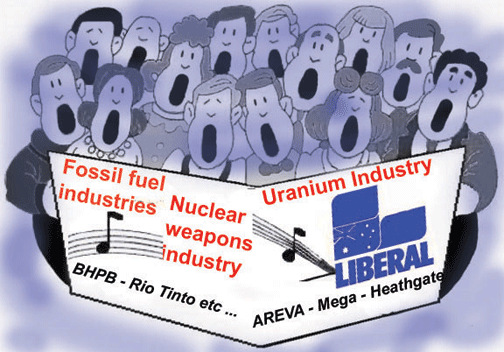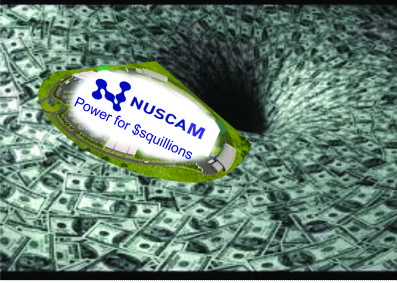
By Jim Green, Aug 18, 2023 https://johnmenadue.com/aukus-a-cover-for-the-coalitions-nuclear-power-agenda/?fbclid=IwAR0tsw-FLtHUY-EFgpbh_b1Lm2jlJSceGe5qkDm0EaLfgKe7NPUlExm4DQw
The federal Coalition’s dissenting report on a Senate inquiry into nuclear power claims that Australia’s “national security” would be put at risk by retaining federal legislation banning nuclear power and that the “decision to purchase nuclear submarines makes it imperative for Australia to drop its ban on nuclear energy.”
The Senate Environment and Communications Legislation Committee released a report into nuclear power on August 11. The majority report, endorsed by Labor and Greens Senators, argued against nuclear power and against the repeal of Howard-era legislation banning nuclear power in Australia. A dissenting report by Coalition Senators argued for repeal of the legislation banning nuclear power.
The majority report concludes that repeal of the legal ban “would create an unnecessary escalation of risk, particularly given Australia is able to utilise readily available firmed renewable technology to secure a reliable, affordable and clean energy system for Australia’s future”.
The Coalition Senators put forward a suite of false and questionable claims in their dissenting report: that nuclear power is expanding worldwide; it is popular; it is important and perhaps essential to underpin the AUKUS nuclear submarines project; promoting low-carbon nuclear proves that the Coalition is serious about greenhouse emissions reductions; and renewables are unreliable and more expensive than nuclear.
The Coalition has yet to state clearly that it will repeal laws banning nuclear power if elected, but it’s only a matter of time. The nuclear push has the full support of Opposition Leader Peter Dutton.
The Coalition’s economic illiteracy
The Coalition Senators’ dissenting report makes a number of absurd economic claims.
It cites Tony Irwin from the SMR Nuclear Technology company, who claims that the costs of nuclear and solar are “basically the same”. He bases his calculation on the assumption that a small modular reactor (SMR) would generate 13 terawatt-hours (TWh) of electricity per year. But reactors typically generate about 7.2 TWh per 1,000 megawatts (MW) of capacity, so a 300 MW reactor (the upper end of the range for SMRs) would generate about 2.2 TWh – nearly six times less than Irwin claims.
Based on that nonsense, Irwin goes on to make the equally absurd claim that until legislation banning nuclear power is removed, “Australia’s power system will continue to be constrained at great cost to the economy.”
SMR Nuclear Technology also fed economic nonsense to a federal parliamentary inquiry in 2019/20. As RenewEconomy editor Giles Parkinson noted, the company’s claim that 100 per cent renewables would cost four times more than replacing coal with nuclear was based on “Mickey-Mouse modelling” by a husband and wife team who used absurd figures for solar and wind and admitted to deliberately ignoring anticipated cost reductions.
Of course there’s no need for Tony Irwin, SMR Nuclear Technology director (and coal baron) Trevor St Baker, or any other nuclear lobbyist to get their facts straight. As long as their claims fit the narrative, they will be parroted by the Coalition and by the Murdoch/Sky echo-chamber.
Cost blowouts
The dissenting report cites John Harries from the Australian Nuclear Association complaining that CSIRO GenCost reports aren’t “looking at the actual builds happening around the world at the moment.”
Be careful what you wish for, John. Does the nuclear lobby really want to draw attention to the six- to twelve-fold cost blowouts in reactors under construction in the US, the UK and France, with the latest cost estimates ranging from A$25-30 billion per reactor?
The dissenting report concludes that: “If nuclear is more expensive than alternatives, as the CSIRO and others claim, then legalising nuclear energy will not change anything because investors will choose to build the cheaper options.”
However there isn’t a single reactor project in the world that isn’t propped up by state support and taxpayer subsidies.
As for private-sector SMR projects, not one has reached the construction stage anywhere in the world — and perhaps none ever will.
The 2015/16 South Australian Nuclear Fuel Cycle Royal Commission commissioned research on the economic potential of two SMR designs: Generation mPower and NuScale Power.
Generation mPower was abandoned in 2017, and NuScale is struggling. Despite lavish US government subsidies, NuScale is struggling to secure private-sector finance to get the project off the ground and it still has licensing hurdles to clear.

NuScale’s latest cost estimates indicate it has no hope of competing with renewables. NuScale estimates capital costs of A$14.4 billion for a 462 MW plant, with levelised costs estimated at A$138 per megawatt-hour. The Minerals Council of Australia states that SMRs won’t find a market unless they can produce power at a cost of A$60‒80 / MWh.
NuScale’s history can be traced to the turn of the century but it hasn’t even begun construction of a single reactor. Likewise, Argentina’s SMR project can be traced back to the last millennium but it hasn’t completed construction of a single reactor.
A dog whistle to climate denialists
The Coalition Senators’ dissenting report claims that nuclear must be in the mix “if we are serious about the reduction of emissions to meet targets”.
But the Coalition isn’t serious about reducing greenhouse emissions. They oppose the Labor government’s “reckless pursuit” of 82 per cent renewable power by 2030. They oppose the modest emissions reduction target of 43 per cent below 2005 levels by 2030.
They waved around a lump of coal in Parliament. They collaborate and conspire with the Minerals Council of Australia, who supplied the lump of coal and who made a global top 10 list of climate policy opponents.
Promoting nuclear power doesn’t provide the Coalition with any cover or credibility. The Climate Council, comprising Australia’s leading climate scientists, speaks for those of us with a genuine interest in reducing greenhouse emissions. The Council issued a policy statement in 2019 concluding that nuclear power plants “are not appropriate for Australia — and probably never will be”.
Economist Prof. John Quiggin notes that, in practice, support for nuclear power in Australia is support for coal. Prof. Quiggin has also described nuclear advocacy in Australia as a dog whistle to climate denialists:
“Opposition Leader Peter Dutton’s call for nuclear power, made as part of his Budget reply speech, should not be taken too seriously. … Dutton’s renewed call can best be understood as a dog whistle to the climate denialists who dominate the party’s base, allowing him to oppose practical measures for decarbonisation without explicitly embracing denialism.”
Nuclear-powered submarines
When announcing the AUKUS agreement in September 2021, then Prime Minister (and secret energy minister) Scott Morrison said: “Let me be clear: Australia is not seeking to establish … a civil nuclear capability.”
Morrison also said that “a civil nuclear energy industry is not a requirement for us to go through the submarine programme.”
However the Coalition Senators’ dissenting report claims that Australia’s “national security” would be put at risk by retaining federal legislation banning nuclear power and that the “decision to purchase nuclear submarines makes it imperative for Australia to drop its ban on nuclear energy.”
They argue that even if nuclear power is more expensive than alternative energy sources, those costs are worth bearing “given how it could contribute to our national defence”.
The Coalition Senators’ arguments are flimsy. The current configuration is for Australia to acquire second-hand US nuclear-powered submarines in a decade or so, with new submarines acquired roughly a decade later. The submarines wouldn’t require refuelling. Nuclear waste storage and disposal won’t be required for at least 20 years.
Establishing a nuclear power industry to support the nuclear submarine project would be using a sledgehammer to crack a walnut.
Further, if a nuclear power industry is necessary to support the submarine project, then countless billions of taxpayer dollars will be necessary to establish that industry — the decision won’t be left to energy marketplace investors as the Coalition Senators argue elsewhere in their dissenting report.
The UK National Audit Office estimates that taxpayer subsidies for two reactors under construction at Hinkley Point — the only reactor construction project in the UK — could amount to £30 billion (A$58.6 billion).
